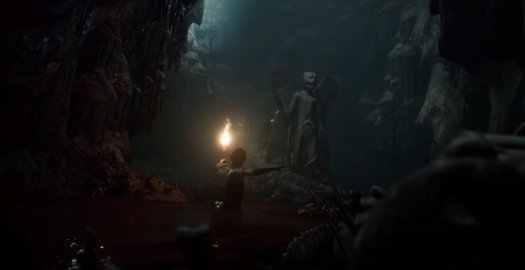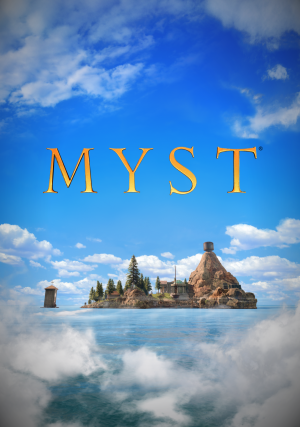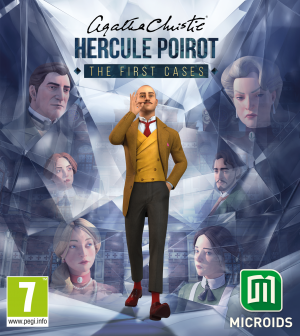Review for The Dark Pictures Anthology: House of Ashes

Annual game series aren’t a very common occurrence, particularly when it comes to adventure games, a genre that relies heavily on narrative and is frequently helmed by small development teams on shoestring budgets, which means the wait between sequels can be lengthy. Supermassive Games, however, has managed to make good on its “one per year” promise for the third year in a row, releasing the latest episode of The Dark Pictures Anthology. House of Ashes delivers the kind of gameplay fans of the series have grown accustomed to while managing to stand apart from what came before through some simple yet effective tweaks to the tested formula.
I was initially skeptical about House of Ashes, even as far back as the brief teaser that played after Little Hope’s credits. The shift from traditional horror movie locations like “derelict ocean freighter” or “spooky New England town” to the desert vistas of the war-torn Middle East had me concerned. I wasn’t convinced the change in scenery, not to mention casting a troop of combat-ready Marines in the main roles, jived with the sort of creepy vibes the series usually aims for. Thankfully, I needn’t have worried: the game turned out to be quite enjoyable on a storytelling level and continued the trend of injecting more cinematic action into its set pieces begun with its predecessor to create some tense moments of its own. It’s not necessarily the scariest, owing to these factors as well as a monster design that’s just a little bit more clichéd and less engrossing than what came before, but the plot and characters clicked for me, making it an enjoyable ride from beginning to end.
The bulk of the game takes place in 2003, during the early stages of the Iraq War, though things actually kick off with a brief opening sequence in 2200 B.C. that gives a bit of historical context to the events that unfold as the game progresses. We meet our cast of Marines after they’ve set up a forward command post in one of Saddam Hussein’s hastily abandoned desert estates. Most of the important players are introduced in short order: the team is led by First Lieutenant Jason Kolchek, serving under CIA Field Officer Rachel King. As the game opens, Rachel’s estranged husband Eric, an Air Force lieutenant colonel, has just arrived unannounced with orders from top brass to take command of the squad for a special recon mission. Satellite imaging has revealed a possible Iraqi chemical weapons storage facility, and the squad is sent to scout and secure the site. This sudden change in leadership goes down about as well as you’d imagine, both with Rachel and the grunts under her command.
From the outset there are a multitude of conflicts, ranging from small to significant, that make these characters work in compelling ways. There’s the obvious issue of being in a hostile country, operating in an active theater of war, with frequent mention made by Jason and his friend and squad mate Nick Kay of a recent tragic gunfight involving a civilian casualty weighing heavily on their minds. But there are also interpersonal issues, like Nick and Rachel enjoying an illicit fling, Jason’s xenophobic distrust of the locals, and Eric’s penchant for throwing his weight around to show his new men who’s boss (though you’re given a say in how abrasive he comes off). It’s a lot of characters to come to grips with all at once, but their relationships with each other are interesting to explore, and role-playing each person during the frequent decision-making moments feels rewarding and helps build an emotional stake in them.
Of course, it’s not all macho rivalries and love triangles; danger threatens externally, as well. On the hunt for the underground weapons storage facility, the Americans find far more than they bargained for, becoming trapped within a series of subterranean temples and caverns in which something ancient and evil has awoken. To make matters worse, several members of the Iraqi military move to intercept the Americans during their mission and suffer the same fate when both sides are surprised by an earthquake that literally collapses the ground beneath their feet. Sergeant Salim Othman and his trigger-happy commanding officer Dar become ancillary antagonists of sorts, disappearing into the same deadly chasm as the Americans, with both sides being just as happy to shoot at the other as to engage the monsters stirring in the dark.
Beyond the intro section in ancient Akkad, which sets up the game’s graphic violence with an opening shot that lingers on a row of freshly severed heads and even gives a brief teaser of the monsters to come, the first hour or so of the game features some strong similarities to James Cameron’s 1986 sci-fi action horror flick Aliens: a requisite team of real tough hombres, armed to the teeth, each one jockeying for dominance amongst themselves, with some good old-fashioned smack talk between the troops. Supermassive’s games have a reputation for occasionally featuring some cringey moments of dialog, but I have to admit I was a fan of the cheese this time around, as even the terrible “Yo’ Mama” jokes felt right at home coming from the lips of a bunch of foul-mouthed jarheads winding each other up.
As we delve deeper – literally and figuratively – the mood changes, from war-movie action to something more unsettling and Lovecraftian, more closely resembling Ridley Scott’s 1979 original Alien in atmosphere, brooding and unfamiliar in its malignancy. The monster design itself isn’t all that triumphant – the discovery of blood-drained corpses, amongst other evidence, leads to them being classified as vampires – but the game is willing to take a few unexpected turns on the road to its conclusion as more details about them are revealed. Finding fully voiced journal pages of an expedition some decades earlier aids in establishing some much-appreciated background lore.
Although it often resembles an interactive movie, House of Ashes includes the same gameplay returning players will have come to expect from the series. It once again heavily employs cinematics to tell much of its story, interspersed with some player-controlled on-foot sections that serve to let you examine your environment, scour for scattered clues, and uncover the odd precognition that reveals either a critical upcoming event or warns of an impending character death. The latter are usually so brief as to be almost useless, but they did help me avoid a death or two along the way. There are still no puzzles to solve, but actions taken in-game, particularly during tense situations, frequently result in timed button presses that must be passed successfully lest an unfavorable outcome jeopardize a particular character’s safety. All five main cast members – Jason, Nick, Eric, Rachel and Salim – can die over the course of the game, and the story will conclude regardless of who survives and who doesn’t.
These Quick Time Events are generally quite simple in nature: gamepads are supported, but when using a keyboard/mouse setup, every single sequence consists of either left- or right-button mouse clicks, with the occasional one thrown in that requires mashing a button repeatedly to succeed. Rhythm-based clicking to mimic the beating of a heart returns in moments of panic, and the access to lots of firearms results in some simple targeting sections where you must swing a reticle over an enemy and click before it has a chance to finish its attack. The aiming mechanic is forgiving, registering hits even if you’re in the right general area, but doesn’t allow for any player agency – I had the bright idea to incapacitate a fleeing, possibly dangerous, civilian with a superficial shot to his leg, but ended up inadvertently making Jason a cold-blooded murderer that mowed down an innocent bystander from behind.
Just as important to survival as the QTEs are the many dialog scenes players participate in, always offering a binary choice between two selections, along with a perpetual third option of staying silent. This is where character relationships are forged and destroyed, and House of Ashes features some strong contenders for fan favorites, including a budding bromance between opposing forces that may (or may not) blossom based on your decisions.
What surprised me most was that the decision to have the main first act play out in broad daylight, before the characters ever encounter the dangers lurking belowground, works in favor of the game’s overall atmosphere. Devoting almost a full hour (a large chunk of time, considering the full experience only clocks in at around six hours) to establishing who’s who and how they all relate to each other was a wise move after the whiplash-inducing introduction given to the cast of Little Hope. This time around, it’s easier to compartmentalize specific cast members into archetypal roles even as the regimen of action-based set pieces keeps things moving. It may not be particularly scary – neither was Little Hope – but the storytelling here works better than ever.
There have also been a few incremental improvements made in the graphics department. Supermassive has a deserved track record of good-looking games, with the exception of some awkward facial animations when attempting to have characters emote realistically. While some of this is still present, there is noticeably less of it this time around. The cast is brought to life via full motion capture of actors, most of whom display a familiar digital face that we’ve seen in one or another of the studio’s previous outings. The most prominent newcomer here is Rachel, voiced by Ashley Tisdale, who represents the title’s biggest draw in terms of name recognition, with top billing understandably going to her. It’s all the more puzzling, then, that Rachel’s facial features and reactions look awkward and out of place far more frequently than her cast mates. This doesn’t seem to be due to any shortcoming on the actress’s part, but rather an unfortunate handling of her visual assets. There are some excellent lighting effects throughout: the bright desert sun is styled as beautifully harsh, starkly white and almost bleached out at times when seeing it filter through a window into a proportionally darker interior space, for example.
The militaristic bent of the story capitalizes on the adrenaline-soaked atmosphere with musical tracks that feature snappy cadences and regimented percussion. Otherwise the score serves the tense mood but doesn’t distinguish itself with any particular standout tracks. It is, however, supported by an effective and well-done ambient soundscape. The cavernous depth of the subterranean environments is on full display as sound echoes far into the distance, and the open areas are often filled with the type of loud silence inherent to grandiose spaces. The creatures themselves sound suitably foreign to human ears, chittering away in gurgling clicks and screeches. A scene next to a gaping abyss is especially effective, with a cacophony of hundreds of agitated screeching monsters heard down below, rising in volume and coming ever closer as a gunfight breaks out up above, pinning the Marines between a rock and a hard place. The dialog, too, pursues authenticity, with the Iraqi soldiers voiced in their native Arabic.
Despite my initial misgivings about the extreme change of scenery and the characters being much more prepared to face danger, House of Ashes turns out to be a great evolution of Supermassive’s catalog of interactive game experiences, with better characterizations and storytelling than before. In doubling down on the inclusion of action elements introduced by its predecessor, the game isn’t terribly scary but is effectively tense throughout and represents another highly polished production. The small improvements and larger changes made here serve up another bloody good time – perhaps even the best in The Dark Pictures Anthology to date.






























